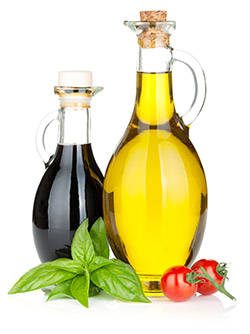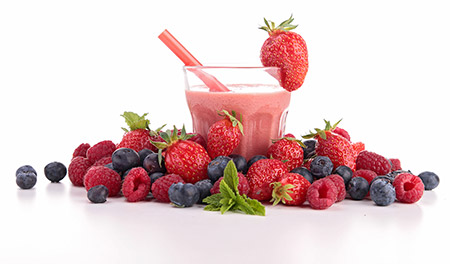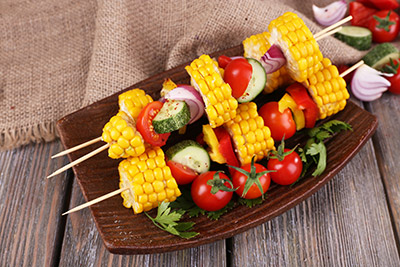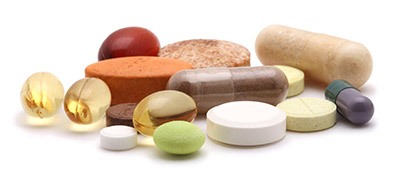Raw Food Living
Doing Raw Right
When it comes to a diet high in raw foods, it is very important to take the time to understand how to do raw right.
Just as with other diets and diet philosophies, if you do not educate yourself on how to eat the right food types in a balanced manner, then you can quickly get yourself into trouble such as gaining a significant amount of weight by over-eating nuts and seeds. Many people who try raw living are not able to sustain it because of the 4 most common pitfalls (see below).
When people begin incorporating more fruits and vegetables into their diet and begin eliminating processed foods, the first thing that usually happens is they gravitate towards food similar to what have been removed (i.e. dense, heavy foods). They excitedly fill their diets with new-found delights, such as:
- • Nuts
- • Seeds
- • Avocados / guacamole
- • Olives
- • Nut butters
- • Nut-based dips
- • Nut-based "cheese"
- • Seed crackers
- • Raw desserts / cookies
- • Nut milks
- • Unrefined oils

With ingredients such as cashews, coconut oil, coconut sugar or honey, and mango, a raw food gourmet chef can produce a cake or dessert that is second to none, with a staggering amount of fat and calories in one slice. How about raw nut-based dips? Or nut or seed-based tortilla chips? Almond nut shakes or fruit and flax seed oil smoothies? Nut pates? Suddenly, the raw foodist is lost in an exciting world of new flavors and filling foods that pack on the fat.
 When oils, nuts, and seeds replace baked goods, meat and dairy, a raw foodist can easily consume far more fat than the average non raw foodist. For example, the average ground beef hamburger contains 62% fat. In comparison, a nut loaf averages over 80% fat. Sunflower, flax, sesame, and hemp seeds have become popular dehydrated crackers for raw foodists and are often eaten with guacamole-based or nut-based dips, or seed cheeses. The fat amount averages over 70% for many meals and smoothies.
When oils, nuts, and seeds replace baked goods, meat and dairy, a raw foodist can easily consume far more fat than the average non raw foodist. For example, the average ground beef hamburger contains 62% fat. In comparison, a nut loaf averages over 80% fat. Sunflower, flax, sesame, and hemp seeds have become popular dehydrated crackers for raw foodists and are often eaten with guacamole-based or nut-based dips, or seed cheeses. The fat amount averages over 70% for many meals and smoothies.
Raw food retreats can dazzle the senses with complex dishes, but what most newbies don't realize is that their new diet often far surpasses the fat content of the standard American diet. Is it a healthier form of fat? Yes, of course. But that does not mean you should gorge on it. Too much fat is too much fat.
Check out the following 2 examples:
- SaladA simple salad with a selection of veggies and fruits starts off being naturally low in fat (on average under 7%). Add a tablespoon of flaxseeds here, a tablespoon of oil there, a big hunk of avocado, (and include all three in larger amounts)... and you suddenly arrive at 80% fat. These "harmless sprinklings" shift the fat scale dramatically. Don't forget he dressing! A popular blended raw dressing containing 2 tablespoons oil, 1/4 cup pine nuts, and 6 oz. avocado can alone instantly turn a raw salad into 75%+ fat.
- Fruit smoothieA simple smoothie of several fruits in water (or coconut water) with kale or Swiss chard is again under 7% fat. But many people use a base of nut milks, add coconut or flaxseed oils, nuts, and seeds... easily topping the 80% fat mark.

On the various raw food retreats I have visited, I never fail to meet seasoned raw foodists who are significantly overweight. A popular raw food retreat on the outskirts of Boulder "uncooks" up a wonderful variety of raw dishes, teaching guests how to incorporate raw meals into their lifestyle. Although the raw food chef (a gourmet chef of incredible skill and talent in the raw food world), fills the lunch and dinner table with a myriad of nut and seed-based dishes to help newbies see the variety available, she eats very little herself. When I asked what her typical daily diet consisted of, she responded with: "Most of my meals are mono meals (eating one food item) - I never eat heavy nut or seed-based meals on a daily basis. My goal is to share with newbies the possibilities of raw, and how to add flavor and excitement to raw living. But eating these high fat dishes on a daily basis is not healthy or sustainable."
Raw fats are unquestionably better than cooked fats, especially when they are from whole plant sources. But such a high quantity of fat is far from healthy, and not only places a large strain on the digestive system, but causes us to feel sluggish and drained of energy. A healthy raw food diet over the long term requires a different approach. Aim for:

 The primary reason many raw foodists crave foods such breads, pastas, rice, cookies, and all the things they have given up is because their diet is severely lacking in the carbohydrates they need from fruits and vegetables. Carbohydrates are the primary fuel source for the body (and the only fuel source for the brain), and if you deny yourself this fuel, you will instinctively crave foods that contain it.
The primary reason many raw foodists crave foods such breads, pastas, rice, cookies, and all the things they have given up is because their diet is severely lacking in the carbohydrates they need from fruits and vegetables. Carbohydrates are the primary fuel source for the body (and the only fuel source for the brain), and if you deny yourself this fuel, you will instinctively crave foods that contain it.
Those new to raw foods will attempt to satiate the craving with high fat foods (see above) not realizing that the satiation provided by vegetables and sweet fruits is what helps prevent these cravings, and high fat foods drain you of energy and cause you to feel sluggish. This lack of carbohydrates drives many to go back to their old eating habits.
Not only are there are there many raw foods to choose from, but there is also a limitless variety of fun and easy-to-make recipes that create new flavors. There are many raw food salad dressings that can be blended using different fruits or vegetables and stored in the fridge to last for days. Using a spiralizer to spiralize beets and zucchini and mixing them with tomatoes, scallions, garlic, and spring onions is not only very tasty, but is much lighter and healthier than the average heavy pasta meal.
Armed with just a little knowledge on how to efficiently create new dishes, sauces, and dips, raw food living suddenly becomes much more fun and exciting.
 Eating a diet that is 100% raw is not necessary to achieve a state of vibrant health, nor do I recommend it for most people. Not only is it far too difficult a transition for most people, but there are numerous foods that become much more digestible when they have been lightly cooked. Depending on the climate, the addition of warmer foods may also just feel right.
Eating a diet that is 100% raw is not necessary to achieve a state of vibrant health, nor do I recommend it for most people. Not only is it far too difficult a transition for most people, but there are numerous foods that become much more digestible when they have been lightly cooked. Depending on the climate, the addition of warmer foods may also just feel right.
Some people thrive on raw foods alone, but others do not. Some are happier incorporating raw dairy, while others do not feel the need. It is much more important to pay close attention to how your body responds and reacts to the foods you give it, and honor its needs as it changes and evolves. You may find that a 75% works much better for you than a 90% raw diet, but at a later time discover 90% to be a better choice for your body.
 By giving your body a continuous supply of raw foods in your diet, you will have a far superior nutritional advantage. If done correctly, a healthy raw food diet filled with at least 75% antioxidant and nutrient rich fruits and vegetables should require little to no supplementation, especially when organic.
By giving your body a continuous supply of raw foods in your diet, you will have a far superior nutritional advantage. If done correctly, a healthy raw food diet filled with at least 75% antioxidant and nutrient rich fruits and vegetables should require little to no supplementation, especially when organic.
Try to avoid the hype preached by any raw food websites or raw food guru that tell you to pop an array of expensive supplements and powders. You will quickly go broke on your way to getting healthy and it is completely unnecessary. Like liquid oils, most supplements are fractionated products where specific nutrients have been extracted and therefore are much less effective than when found in their original whole foods. Most are also synthetic and have a different biological impact on the body as compared to their natural counterpart.
In general, focus on using supplements only if you have a health condition that requires them, and when that health condition is resolved, stop taking the supplement. There are two notable exceptions:
- Vitamin B12Vitamin B12 comes from bacteria from the food we eat, and is produced internally by our bodies. It is also efficiently recycled in the body and can last over 2 years in a healthy adult without requiring direct dietary sources. But in this day and age, with the depletion of our soils and the pollution of our planet, non-organic plant foods are no longer considered a reliable source of B12. A deficiency is now common in meat eaters, vegetarians, vegans, and raw foodists alike, but more common in vegans.
Although many raw foodists receive plenty of vitamin B12 from a raw diet (more so with organic foods where this nutrient has not been destroyed by pesticides), studies consistently demonstrate that raw food vegans are more deficient in B12. The recommended levels are >400pg/ml, with raw vegans averaging <100-200pg/ml.
- Vitamin D3Depending on the climate you live in and how much year-round sunlight you are exposed to, vitamin D supplementation may be required. Vitamin D is a common deficiency, especially in northern countries such as Canada, the northern US, and northern Europe. The continual application of sunscreen can also block vitamin D absorption and cause a deficiency, even for those living in sunnier climates. Studies are also finding that the toxic chemicals in these sunscreens are far more likely to contribute to skin cancer than the sun itself.
When it comes to supplements, avoid self-diagnosing. If your diet is varied and healthy with plenty of fresh and organic fruits and vegetables, you should rarely need to take daily supplements, especially multi-vitamins. Instead, monitor your levels of these nutrients in your body by taking a simply yearly test, and only take supplementation if you are deficient. Otherwise, they are a waste of your money. At best, high quality supplements should be used only to help resolve a health issue, and then be discontinued when they are no longer needed.
Make sure the supplements you choose are from whole foods, and from a reputable manufacturer (preferably in raw form such as the Garden of Life brand which is sold in most health food stores). There are several very commonly manufactured synthetic supplements such as folic acid and vitamin A that have been conclusively shown in health studies to be damaging to your health.
...